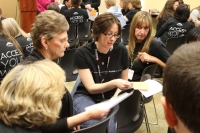Rebranding to Remain Relevant: It's All About Access
Mid-Continent Public Library, Mo.
Innovation Synopsis
Do we still need libraries? This is a question library professionals hear too often for comfort. MCPL believes it is rooted in misunderstanding of the true function of libraries. In response, we rebranded our system around a multi-layered message about access.
Challenge/Opportunity
Like many other libraries, MCPL saw increasing usage throughout the 2000s. Yet community leaders, citizens, and even customers still were frequently asking us whether we were concerned that people wouldn’t use libraries in the future. We set out to understand why the question came up so frequently, and we determined that it is likely due to a misperception about what libraries offer. A much cited OCLC study from 2010 showed that 75% of all respondents said “books” is the word that best describes libraries. Internal polling of our customers showed a similar response. In an increasingly digital world, it only makes sense that people who think of the library as physical books on shelves would worry about the future of the institution. The key, however, is for libraries themselves not to think this way. Newspapers had a very rough transition to the digital age, primarily because they thought of themselves as a bundle of paper instead of as a provider of quality content. Libraries have the chance to learn from that, but we have to encourage the public to think differently about us as well.
Key Elements of Innovation
“Access” makes frequent appearances in conversations about libraries, and is often cited as a prerequisite to success in our modern economy. Around this simple idea, MCPL built a multi-layered brand message that is clear, flexible, and sustainable. A top level message, Access Your World, is used in environments where we speak about the Library as an institution. Complementary messages like Access Community, Access Opportunity, and Access Technology focus the message of Access on services like civic programs, job search resources, and computer assistance. In each message, the word Access is presented in a constant color (black or white) while the idea being accessed is presented in varying colors. These calls to action present targeted messages to our varying groups of constituents, but also compound their value by building the idea that there is a whole world of things to be accessed at the Library. Presenting the new brand took multiple forms. We changed our library cards – the things you check out books with – to Access Passes – the things get you access to all the Library offers. Our frontline staff members are now Access Specialists. Our programming flyers are called Access Guides. A traditional advertising campaign on Access included billboard, radio, print, and video spots. Each service or product selected for the advertising campaign was chosen for its ability to make someone say “I didn’t know the Library did that!” Our web and social media interfaces are now designed to maximize attention to improving Access. Internally, we created an “Access-ability” training program for staff to help them cross-promote services during customer interactions.
Achieved Outcomes
The primary launch of the campaign happened throughout the second half of 2012. The success of the efforts was and will be measured in three ways: stakeholder receptivity to the brand, usage of targeted services, and media performance. Stakeholders have responded quite well to the brand. Customers tell us they love their “Access Passes,” and are regularly making comments about the things they didn’t know the Library did before the campaign. Community leaders have told us they think we are showing the true value of libraries better than ever. And staff are energized by the idea that they are providers of access to information that changes lives. Later this spring we will be post-testing our customers to see what impact we have had on the perception that libraries are about “books”. We expect we will see a noticeable shift away from that notion. Usage of the services highlighted throughout the brand push has increased across the board. From online job resource usage growing 48% to eBook downloads growing by nearly 200%, we saw a great response to the campaign. In terms of media performance, we managed 15 million total impressions throughout the branding campaign. That does not include the impressions of our regular customers within our branch. By spreading the message across different media, we believe we have a high probability of our message having reached over 90% of population in our service area.

